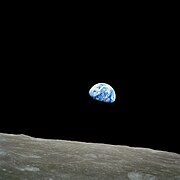

The Moon makes a complete orbit around the Earth with respect to the fixed stars about once every 27.3 days[nb 3](its sidereal period). However, since the Earth is moving in its orbit about the Sun at the same time, it takes slightly longer for the Moon to show its same phase to Earth, which is about 29.5 days[nb 4] (its synodic period).[4] Unlike most satellites of other planets, the Moon orbits near the ecliptic and not the Earth's equatorial plane. It is the largest moon in the solar system relative to the size of its planet. (Charon is larger relative to the dwarf planet Pluto.) The natural satellites orbiting other planets are called "moons", after Earth's Moon.
Most of the tidal effects seen on the Earth are caused by the Moon's gravitational pull, with the Sun making a somewhat smaller contribution. Tidal drag slows the Earth's rotation by about 0.002 seconds per day per century.[63] As a result of the conservation of angular momentum, the slowing of Earth's rotation is accompanied by an increase of the mean Earth-Moon distance of about 3.8 m per century, or 3.8 cm per year.[64] The Moon is exceptionally large relative to the Earth, being a quarter the diameter of the planet and 1/81 its mass. However, the Earth and Moon are still commonly considered a planet-satellite system, rather than a double-planet system, since the common centre of mass of the system (the barycentre) is located about 1,700 km beneath the surface of the Earth, or about a quarter of the Earth's radius. The surface of the Moon is less than one-tenth that of the Earth, and only about a quarter the size of the Earth's land area (or about as large as Russia, Canada, and the U.S. combined).
The current obliquity of the Moon means that the Sun never rises above 1.85° at the poles. The axial tilt of the Moon has remained at its present orientation for the past two billion years, allowing the craters at the poles to remain in permanent shadow for that length of time.[65] Prior to that point, the Moon had much larger values for its obliquity, possibly reaching angles as high as 77° for periods of several hundred thousand years.[66]
In 1997, the asteroid 3753 Cruithne was found to have an unusual Earth-associated horseshoe orbit. However, astronomers do not consider it to be a second moon of Earth, and its orbit is not stable in the long term.[67] Three other near-Earth asteroids, 54509 YORP, (85770) 1998 UP1 and 2002 AA29, which exist in orbits similar to Cruithne's, have since been discovered.[68]


No comments:
Post a Comment